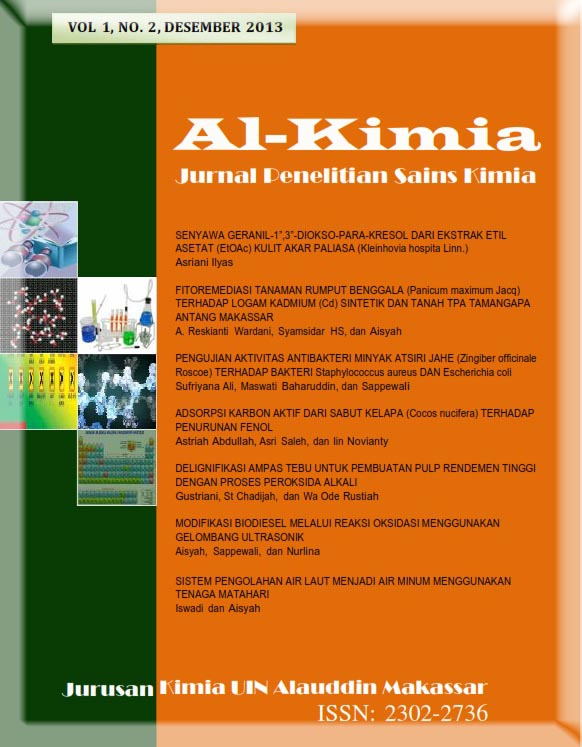Modifikasi Biodiesel Melalui Reaksi Oksidasi Menggunakan Gelombang Ultrasonik
Abstract
Biodiesel is an alternative energy fuel that is sustainable and environmentally safe. However, biodiesel has a higher cloud point than fuel diesel because it contains several saturated fatty acids such as oleic acid, linoleic and linolenic acid so that biodiesel tend to solidify at a temperature higher than the freezing point of diesel. This study aims to modify biodiesel from candlenut oil (Aleurites moluccana) through oxidation reaction by KMnO4 using ultrasonic equipment. The products obtained were analyzed using FTIR and GCMS instrument. FTIR analysis showed that spectral data of the four modified samples which run in 20, 30, 40 and 50 minutes practically similar. The methyl ester products are characterized by typical bands at specific frequencies such as stretch of C = O; C-C; C-H (sp3) and = C-H (sp2). Fragmentation patterns by GCMS showed that the oxidation reaction in 20, 30, 40 and 50 minutes did not undergo bond disconnection. The components produced is methyl palmitate, methyl linoleate, methyl oleate, heksadekanoat acid, 9, 12 and 9,17oktadekadienal oktadekadienoat acid.Downloads
References
Cui, X., et. al.., 2013, A Numerical Study of the Effects of Fame Blends on Diesel Combustion and Emissions Characteristics Using a 3-D Cfd Code Combined with Detailed Kinetics and Phenomenological Soot Formation Models, SAE Int. J. Fuels Lubr, (6): 839-885.
Damyanova, B. N., 2004, Lipids Analysis by TLC. In:Encyclopedia of Chromatography, New York: Marcel Dekker, h.1-3.
Departemen Agama RI, 1977, Al-Qur’an dan Terjemahannya, Surabaya: PT. Medika Cipta.
Fajar, R., 2012, Re-Formulasi Biodiesel Jatropha curcas l.: Optimasi Key- Properties dengan Modifikasi Komposisi FAME (Fatty Acide Methyl Esters) dan Karakterisasi Pembakaran pada Motor Diesel, Skripsi, Jakarta: Fak. Teknik UI.
Knothe, G., 2001, Historical Perspective On Vegetable Oil-Based Diesel Fuels, Inform, (12) : 1103-1107.
Meher, L. C., et. al.., 2006, Technical Aspects of Biodiesel Production by Transesterification – A Review, Renew. Sust. Energ. Rev. (10) : 248.
Muniyappa, P. R., et. al.., 1996, Improved Conversion of Plant Oils and Animal Fats Into Biodiesel and Co-Product, Bioresc Technol., (56): 19-25.
Noureddini, H., et. al.., 1998, A Continuous Process for the Conversion of Vegetable Oils Into Methyl Esters of Fatty Acids, J. Am. Oil. Chem. Soc. (75): 1775.
Pamata, Nathasya, 2008, Sintesis Metil Ester (Biodiesel) dari Minyak Biji Kemiri (Aleurites moluccana) Hasil Ekstraksi Melalui Metode Ultrasonokimia, Skripsi, Jakarta: FMIPA UI, 28-29.
Rodrigues, S., et. al.., 2009, Optimization of the Production of Ethyl Esters by Ultrasound Assisted Reaction of Soybean Oil and Ethanol, Brazil. J. Chem. Eng. (26) : h. 361-366.
Stavarache, C., et. al.., 2005, Fatty Acids Methyl Esters from Vegetable Oil by Means of Ultrasonik Energy, Ultrason. Sonochem : 367.
Spannring, P.,et. al.., 2014, Fe(6-Me-PyTACN)-catalyzed, One-pot Oxidative Cleavage of Methyl Oleate and Oleic Acid into Carboxylic Acids with H2O2 and NaIO4. Catal. Sci. Technol., (4) : 708-716.
Standar Nasional Indonesia, 2008, Standard dan Mutu Bahan Bakar Nabati (Biofuel): SNI-7431. Jakarta: SNI, 2-3.
Sulistyo, H., et. al.., “Crude Candlenut Oil Ethanolysis to Produce Renewable Energi at Ambient Condition” Proceedings of the World Congress on Engineering and Computer Science”. WCECS, no.1 (2009): h. 1-4.
Thanh, L.., et. al.., 2010, Ultrasound-assisted Production of Biodiesel Fuel from Vegetable Oils in a Small Scale Circulation Process, Bioresc. Tehnol, (101): 639-645.
Zhang, Choungn, et. al., 2013, Soy-castor Oil Based Polyols Prepared Using A Solvent-free and Catalyst-free Method and Polyurethanes Therefrom, Green Chem, (15): 1477-1484.
Authors who publish with this journal agree to the following terms:
1) Authors retain copyright and grant the journal right of first publication with the work simultaneously licensed under a Creative Commons Attribution License that allows others to share the work with an acknowledgement of the work's authorship and initial publication in this journal.
2) Authors are able to enter into separate, additional contractual arrangements for the non-exclusive distribution of the journal's published version of the work (e.g., post it to an institutional repository or publish it in a book), with an acknowledgement of its initial publication in this journal.
3)Authors are permitted and encouraged to post their work online (e.g., in institutional repositories or on their website) prior to and during the submission process, as it can lead to productive exchanges, as well as earlier and greater citation of published work (See The Effect of Open Access).


